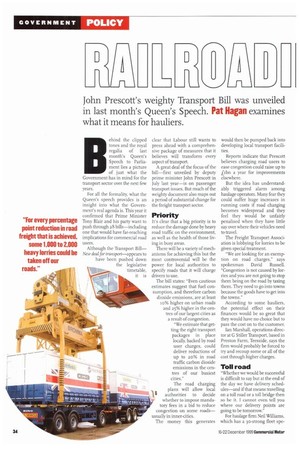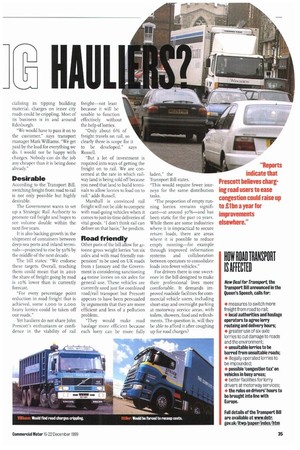John Prescott's weighty Transport Bill was unveiled in last month's Queen's Speech. Pat Hagan examines what it means for hauliers.
Page 36

Page 37

If you've noticed an error in this article please click here to report it so we can fix it.
ehind the clipped tones and the royal regalia of last month's Queen's Speech to Parliament lies a picture of just what the Government has in mind for the transport sector over the next few years.
For all the formality, what the Queen's speech provides is an insight into what the Government's real agenda is. This year it confirmed that Prime Minister Tony Blair and his party want to push through 28 bills—including one that would have far-reaching implications for commercial road users.
Although the Transport Bill— New deal for transport—appears to have been pushed down the legislative OPPtimetable,
clear that Labour still wants to press ahead with a comprehensive package of measures that it believes will transform every aspect of transport.
A great deal of the focus of the bill—first unveiled by deputy prime minister John Prescott in July last year—is on passenger transport issues. But much of the weighty document also maps out a period of substantial change for the freight transport sector.
Priority
It's clear that a big priority is to reduce the damage done by heavy road traffic on the environment, as well as the health of those living in busy areas.
There will be a variety of mechanisms for achieving this but the most controversial will be the power for local authorities to specify roads that it will charge drivers to use.
The bill states: "Even cautious estimates suggest that fuel consumption, and therefore carbon dioxide emissions, are at least to% higher on urban roads and 25% higher in the centres of our largest cities as a result of congestion. "We estimate that getting the right transport packages in place locally, backed by road user charges, could deliver reductions of up to zo% in road traffic carbon dioxide emissions in the centres of our busiest cities."
The road charging plans will allow local authorities to decide whether to impose mandatory fees in a bid to reduce congestion on some roads— usually in inner-cities.
The money this generates would then be pumped back into developing local transport facilities.
Reports indicate that Prescott believes charging road users to ease congestion could raise up to fibn a year for improvements elsewhere.
But the idea has understandably triggered alarm among haulage operators. Many fear they could suffer huge increases in running costs if road charging becomes widespread and they feel they would be unfairly penalised when they have little say over where their vehicles need to travel.
The Freight Transport Association is lobbying for lorries to be given special treatment.
"We are looking for an exemption on road charges," says spokesman David Russell. "Congestion is not caused by lorries and you are not going to stop them being on the road by taxing them. They need to go into towns because the goods have to get into the towns."
According to some hauliers, the potential effect on their finances would be so great that they would have no choice but to pass the cost on to the customer.
Ian Marshall, operations director at G Stiller Transport, based in Preston Farm, Teesside, says the firm would probably be forced to try and recoup some or all of the cost through higher charges.
Toll road
"Whether we would be successful is difficult to say but at the end of the day we have delivery schedules—and if that means travelling on a toll road or a toll bridge then so be it. I cannot even tell you where our delivery points are going to be tomorrow."
For haulage firm Neil Williams, which has a 3o-strong fleet spe cialising in tipping building material, charges on inner city roads could be crippling. Most of its business is in and around Edinburgh.
"We would have to pass it on to the customer," says transport manager Mark Williams. We get paid by the load for everything we do. I would not be happy with charges. Nobody can do the job any cheaper than it is being done already."
Desirable
According to the Transport Bill, switching freight from road to rail is not only possible but highly desirable.
The Government wants to set up a Strategic Rail Authority to promote rail freight and hopes to see volume double within the next five years.
It is also backing growth in the shipment of containers between deep-sea ports and inland terminals—projected to rise by 50% by the middle of the next decade.
The bill states: "We endorse these targets. Overall, reaching them could mean that in 2010 the share of freight going by road is io% lower than is currently forecast.
"For every percentage point reduction in road freight that is achieved, some Lao° to 2.,000 heavy lorries could be taken off our roads."
Yet hauliers do not share John Prescott's enthusiasm or confidence in the viability of rail freight—not least because it will be unable to function effectively without the help of lorries.
"Only about 6% of freight travels on rail, so clearly there is scope for it to be developed," says Russell.
"But a lot of investment is required into ways of getting the freight on to rail. We are concerned at the rate in which railway land is being sold off because you need that land to build terminals to allow lorries to load on to rail," adds Russell.
Marshall is convinced rail freight will not be able to compete with road-going vehicles when it comes to just-in-time deliveries of vital goods. "I don't think rail can deliver on that basis. ,"he predicts.
Road friendly
Other parts of the bill allow for 4'tonne gross weight lorries "on six axles and with road friendly suspension" to be used on UK roads from r January and the Government is considering sanctioning 44-tonne lorries on six axles For general use. These vehicles are currently used just for combined road/rail transport but Prescott appears to have been persuaded by arguments that they are more efficient and less of a pollution problem.
"They would make road haulage more efficient because each lorry can be more fully laden," the Transport Bill states.
"This would require fewer journeys for the same distribution tasks.
"The proportion of empty running lorries remains significant—at around 30%—and has been static for the past to years. While there are some industries where it is impractical to secure return loads, there are areas where it is possible to reduce empty running—for example through improved information systems and collaboration between operators to consolidate loads into fewer vehicles."
For drivers there is one sweetener in the bill designed to make their professional lives more comfortable. It demands improved roadside facilities for commercial vehicle users, including short-stay and overnight parking at motorway service areas, with toilets, showers, food and refreshments. The question is, will they be able to afford it after coughing up for road charges?
HOW ROAD TRANSPORT IS AFFECTED
New Deal for Transport, the Transport Bill announced in the Queen's Speech, calls for:
measures to switch more freight from road to rail; • local authorities and haulage operators to agree lorry routeing and delivery hours; 40 greater use of six-axle lorries to cut damage to roads and the environment;
• unsuitable lorries to be barred from unsuitable roads; • illegally operated lorries to be impounded; • possible 'congestion tax' on vehicles in busy areas; • better facilities for lorry drivers at motorway services; • the rules on drivers' hours to be brought into line with Europe.
Full details of the Transport Bill are available at wwwdetr. gov.uk/itwp/paper/index/htm
































































































